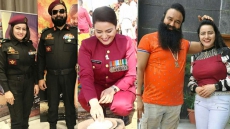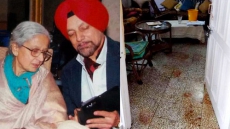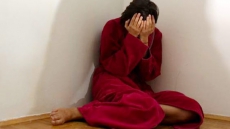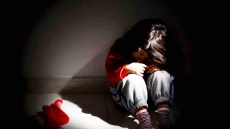Dressed to the nines and swaying to the thrum of dhaaks (drums), residents of West Bengal plunged into merriment on Tuesday marking the first day of Durga Puja - the biggest festival in this part of the world.
"Sasthi" or "Bodhan" -- the welcoming of the Durga idols and her pantheon -- signalled the start of the five-day puja as the eastern metropolis welcomed its patron goddess with the beats of dhaak, aroma of incense and fragrance of shiuli flowers.
Armed with Sharadotsav, a new app by West Bengal Tourism -- which lists the best pandals (marquees) in the city -- denizens and tourists, cutting across age and class barriers, kicked off their sojourn through some eclectic collection of pandals.
Others simply chose to follow the general direction of the crowd.
The carnival-like atmosphere had an early start this year with many prominent pujas throwing their marquees open to the public three to four days in advance.
Greetings of "Shubho Sharadiya" and "Jai Durga" via social media and messengers as also the traditional "namaskar" and shout-outs to neighbours exemplified the enthusiasm of the public.
Everyone hitting the streets of Kolkata, under heavy security arrangement, was spellbound by the festive look of the city itself -- an entire street covered in 'alpona' (traditional pattern), kiosks of football-themed fish items lining the streets as also replicas of London streets and skyscrapers tearing across the New York City skyline.
Balancing plates of cutlets (fritters) and daab (green coconut with water) while precariously manoeuvering through the crowded alleys, revellers patiently queued up for a look at the pandals.
The community pujas in the city number over 3,000 this year, while thousands more are observed in the towns and villages across the state.
At the popular Maddox Square puja, marked for its expansive space conducive to adda (discussion sessions), debates and deliberations were in full swing amid the throbbing beats of the dhaaks (traditional drums).
Festivities in small towns and villages have been scaled up this year to match with their urban counterparts.
Sex workers' communities in Bishnupur, Basirhat and Cooch Behar as well as Sonagachi in Kolkata had their own celebrations, signifying the festival's inclusivity.
The puja is usually a five-day event with Sasthi (September 26) and the subsequent four days - Saptami, Ashtami, Navami and Dashami - marked by frenzied pandal-hopping (visiting marquees) in new clothes, meeting friends and family and stuffing oneself to the brim with traditional delicacies.
Chief Minister Mamata Banerjee wished the people on Sasthi via social media.
The Metro Railways announced special night-long services (224 services each day between 1.40 p.m. and 4 a.m.) from Saptami to Navami to tackle the additional rush of pandal hoppers.
Sasthi - the sixth day of the lunar calendar - also marked the beginning of the puja rituals.
Kalparamvo (the beginning of the Pujas), Bodhan (the consecration of Ma Durga's idol), Amantran (inviting the Goddess) and Adhivas (sanctifying the stay of the Goddess in the exact spot where the puja is being held) - were performed in community puja marquees and households where the deity is being worshipped with zeal.
According to the Ramayana, before attacking Lanka in search of his wife Sita, Lord Rama had performed Durga Puja in autumn - a time when the gods sleep, according to the Hindu religious texts.
So Lord Rama had to first wake up the goddess prematurely, and as such, the awakening in the autumnal festival is called "Akal (untimely) Bodhan" of the goddess.
However, mythology also states that the puja celebrates the annual descent of Goddess Durga, the slayer of the demon Mahishashur, accompanied by her four children - Ganesh, Kartik, Lakshmi and Saraswati - on the Earth to visit her parents.
The goddess, astride a lion and wielding an array of weapons in her ten hands, stays for four days to eradicate all evil from the Earth before returning to her husband Lord Shiva at Kailash on Dashami.





